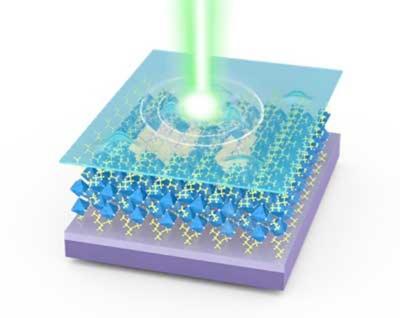NUS scientists have found that the light emission properties of molecularly thin two-dimensional (2-D) hybrid perovskite can be tuned in a highly reversible way for ultrathin optoelectronic applications. A highly efficient photodetector has been fabricated using hybrid perovskites with the thickness of a single quantum well.
 An impression of laser interaction with a molecularly thin 2D perovskites encapsulated by hexagonal boron nitride (blue layer). (Image: NUS)
An impression of laser interaction with a molecularly thin 2D perovskites encapsulated by hexagonal boron nitride (blue layer). (Image: NUS)
Each basic unit of a 2D hybrid perovskite is constructed using a semiconducting layer of inorganic material sandwiched between two organic insulating layers. While researchers have studied layered perovskites in their bulk form for many years, the properties of these crystals when their thickness is thinned down to a few and single layers have largely not been explored.
Using a temperature controlled crystallization method, the researchers synthesized centimeter-sized perovskite single crystals of the Ruddlesden-Popper phase (a form of layered perovskite structure). These specially prepared crystals are much larger than the usual micron-sized ones and allowed the team to peel off thin layers from it using the 'scotch tape' method (similar method used for obtaining graphene from graphite). These ultrathin crystals were then used for the experiments.
Prof Loh said, 'Unlike bulk perovskites where the organic chains of adjacent layers are interdigitated and tightly-packed, the layer of organic chain on ultrathin perovskites can 'relax' more easily under laser or thermal activation. This 'relaxation' process changes their light emission properties. We found that the light emission can reverse back to its initial state by constraining ('de-relaxing') the surface of the ultrathin perovskite layer.'
'We have also studied the atomic structure of these perovskites using the QPlus atomic force microscope. Depending on the supplied thermal energy, the organic layers on the surface can assemble and change the optoelectronic properties of the crystal in a reversible manner. This could potential be used for developing strain-tuneable optoelectronic devices,' added Prof Loh.

